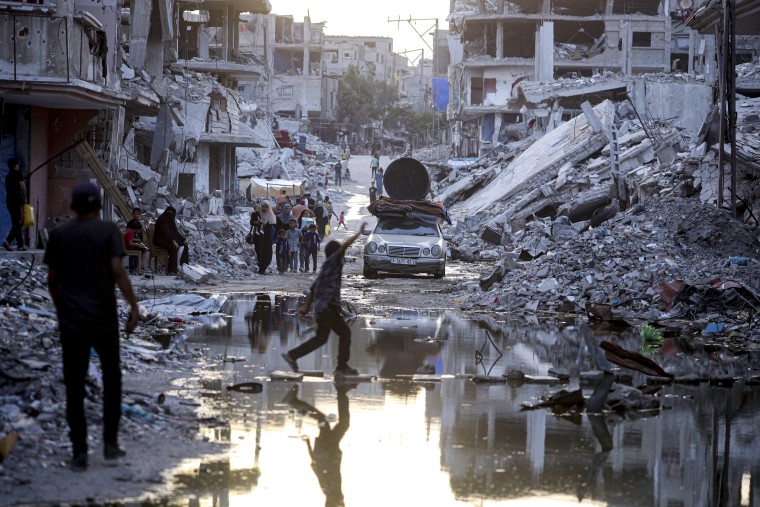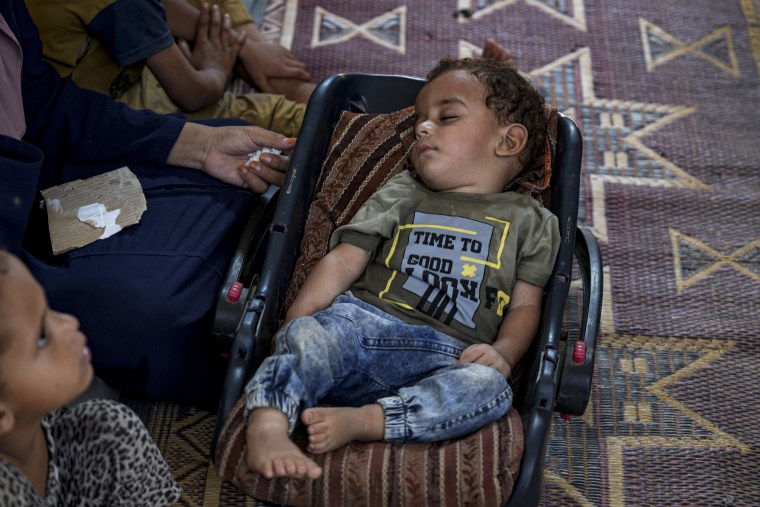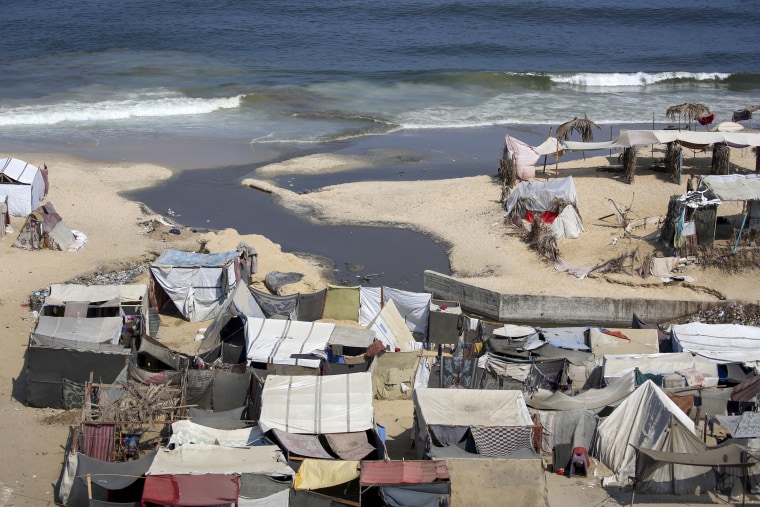Aug. 31, 2024, 4:27 PM UTC
By Freddie Clayton
After a rare and relatively swift six weeks of talks, Israel and Hamas have agreed to three separate three-day pauses in fighting, starting Sunday in central Gaza, to allow for the vaccination of some 640,000 children against polio amid fears that the outbreak of the potentially fatal virus could spread beyond the territory.
Eleven months of Israeli bombardment have created the ideal conditions to bring polio — which is spread mainly when contaminated stool from an infected person is orally ingested — back from near-eradication: destroyed water and sewage lines; hundreds of thousands crowded into patches of land lacking toilets and sewage systems; and a health care system that has collapsed under the weight of hostilities and war injuries, leading to a dramatic drop in routine vaccinations.
It’s a sanitation crisis so dire that it has put people at risk of ingesting traces of infected human waste. Georgios Petropoulos, head of the U.N.’s humanitarian agency in Gaza, told NBC News from Rafah that it was “almost impossible” to steer clear of disease.
“I haven’t seen anything like it,” he said. “There’s rivers of human feces.”
 A boy navigates the sewage flowing in the streets of Khan Younis last month.Jehad Alshrafi / AP
A boy navigates the sewage flowing in the streets of Khan Younis last month.Jehad Alshrafi / AP
The diagnosis of a 10-month-old boy with polio last week — the first case in Gaza in 25 years — added urgency in a war where deals have otherwise proved elusive.
In an interview with NBC News, the boy’s mother, Naveen Abu Al-Jidyan, said her son, Abdel Raman, should soon be learning to walk, but instead his leg has been paralyzed.
Speaking by the tent where he lives with his wife and 10 children, Amjad Abu Al-Jidyan, Abdel Raman’s father, blamed his family’s poor health on a lack of hygiene.
“There is no hygiene, the hygiene supplies are unavailable,” Abu Al-Jidyan said. “We don’t have chlorine, soap, or anything.”
He said he waits for hours to collect just a gallon of water for his family. “God knows if the water is potable or not,” he added.
While sewage flows through the streets and Palestinians scramble to find clean water, avoiding human waste has become a difficult and potentially life-threatening challenge.
 10-month-old Abdel Raman Abu Al-Jidyan is the first child to be diagnosed with polio in Gaza in 25 years.Abdel Kareem Hana / AP
10-month-old Abdel Raman Abu Al-Jidyan is the first child to be diagnosed with polio in Gaza in 25 years.Abdel Kareem Hana / AP
The highly infectious virus attacks the nervous system and can lead to spinal and respiratory paralysis, and even death. In the 20th century, before it was mostly eradicated, polio was among the most feared diseases in the world, killing or paralyzing half a million people a year, according to the World Health Organization. Some experts now fear it may already be widespread in Gaza.
After leaving their homes to escape the conflict, most of the enclave’s 2.2 million people are now confined to a humanitarian area smaller than Manhattan, the majority in makeshift, overcrowded shelters without sanitation infrastructure that safely separates waste from human contact.
Untreated sewage flows openly near these dwellings, where flies travel freely from feces to fluids and food. Waste seeps into the surrounding environment and contaminates the dwindling fresh water supplies.
“There’s people with a hole in the tent and they have to defecate out of that hole,” Petropoulos said. “The same tent where they sleep.”
People are also running out of water to wash their hands or clean themselves, with many resorting to seawater, despite the fact that untreated sewage is being pumped into the Mediterranean Sea with wastewater treatment plants shut down.
“They know the water from the sea is not hygienic in any state,” Louise Wateridge, a spokesperson for UNRWA, the United Nations agency for Palestinian refugees, told NBC News last month. Using it, she said, is “an act of desperation.”
According to Oxfam America, less than 4% of fresh water is now drinkable in Gaza. UNRWA estimates that almost 70% of water and sanitation facilities and infrastructure has been destroyed or damaged in Israel’s bombardment.
Meanwhile, vaccine rates have dropped enough since the start of the war to allow for the re-emergence of polio. In 2022, vaccine coverage was estimated at 99% for two doses, but this has dropped to less than 90%, according to the latest WHO data.
According to UNICEF, poor sanitation conditions mean that at least 95% of children will need to receive two vaccine doses in order to reduce chances of an outbreak in the region.
 A stream of raw sewage from a makeshift tent camp empties into the Mediterranean Sea.EYAD BABA / AFP – Getty Images
A stream of raw sewage from a makeshift tent camp empties into the Mediterranean Sea.EYAD BABA / AFP – Getty Images
The first three-day vaccination campaign will start Sunday in central Gaza as international agencies send 1.6 million doses of the vaccine to the conflict zone. The daily pauses in fighting are scheduled to take place between 6 a.m. and 3 p.m. local time.
A second three-day campaign will take place in southern Gaza from Sept. 5, and a third in northern Gaza starting on Sept. 9.
The Israeli military’s humanitarian unit said on Wednesday that vaccinations would be conducted in coordination with the Israeli military “as part of the routine humanitarian pauses that will allow the population to reach the medical centers where the vaccinations will be administered.”
After polio was detected in Gaza’s sewers in July, the Israeli government began offering vaccinations to troops returning from Gaza.
Israel was prompted to retaliate in Gaza after Hamas and other militants staged a surprise attack on Oct. 7, killing some 1,200 people, primarily civilians. Israel’s retaliatory offensive has so far killed more than 40,000 Palestinians and caused widespread destruction.
As hundreds of thousands of Palestinians trudge through sewage and garbage each day without access to clean water or soap, they remain at risk of polio and a litany of other diseases.
Earlier in August, UNWRA reported 40,000 cases of Hepatitis A, another virus that can be transmitted through ingestion of contaminated water. In June, it warned of the risks of a cholera outbreak amid severe water shortages.
There have also been at least 500,000 cases of diarrhea, while the WHO has reported over 100,000 cases of lice and scabies.
Fewer than half of the territory’s hospitals and clinics remain operational and are overwhelmed with the injured, with aid agencies reporting that doctors are struggling to treat a huge caseload of dysentery and pneumonia.
While polio may have rallied Israel and Hamas into action, the resurrection of the disease in Gaza after 25 years speaks to the gravity of a sanitation crisis that is set to continue beyond September’s vaccinations.
Freddie Clayton
Freddie Clayton is a freelance journalist based in London.



